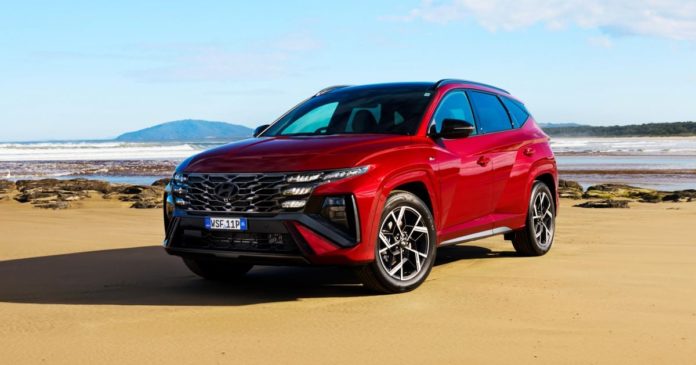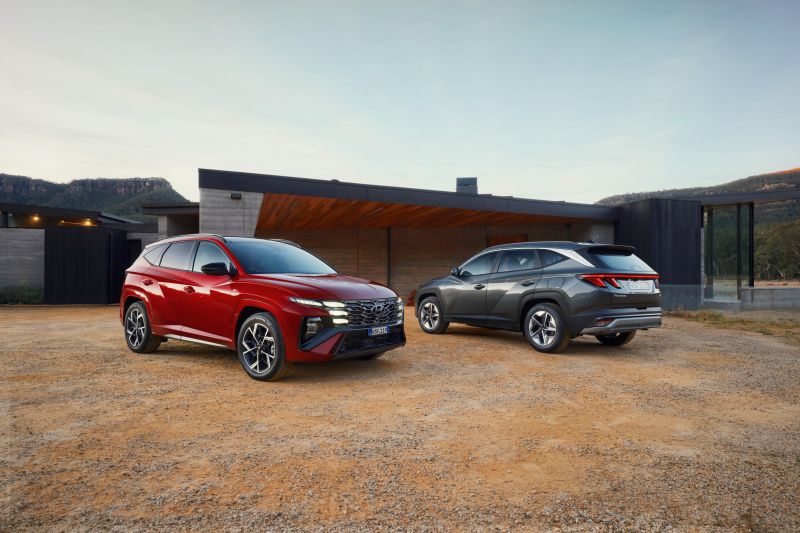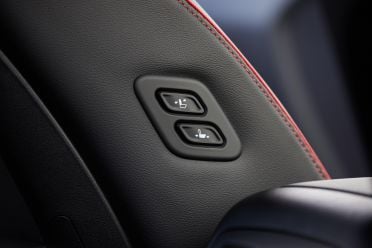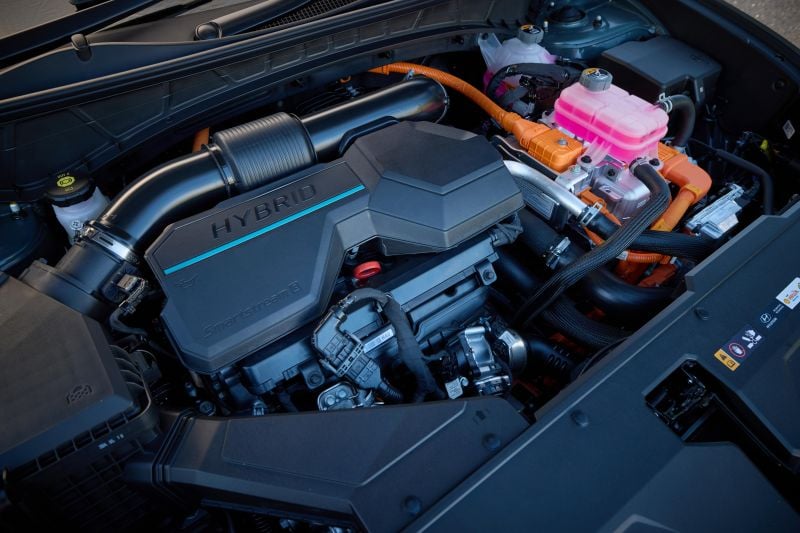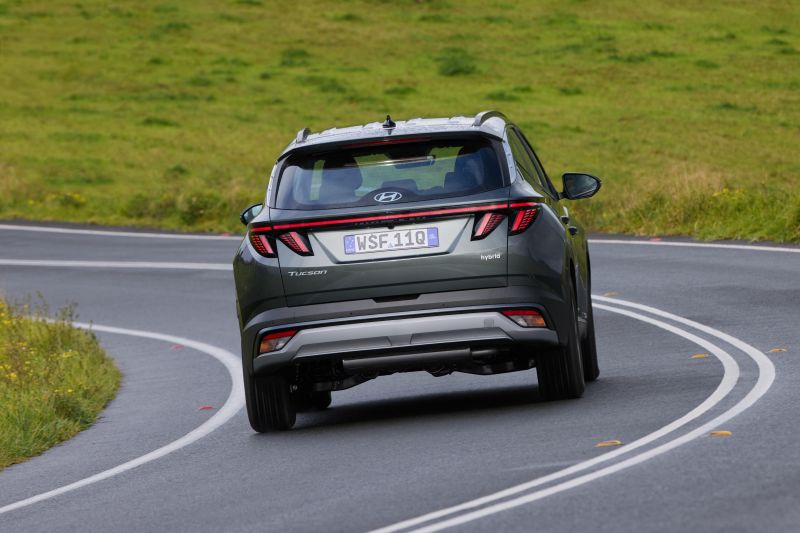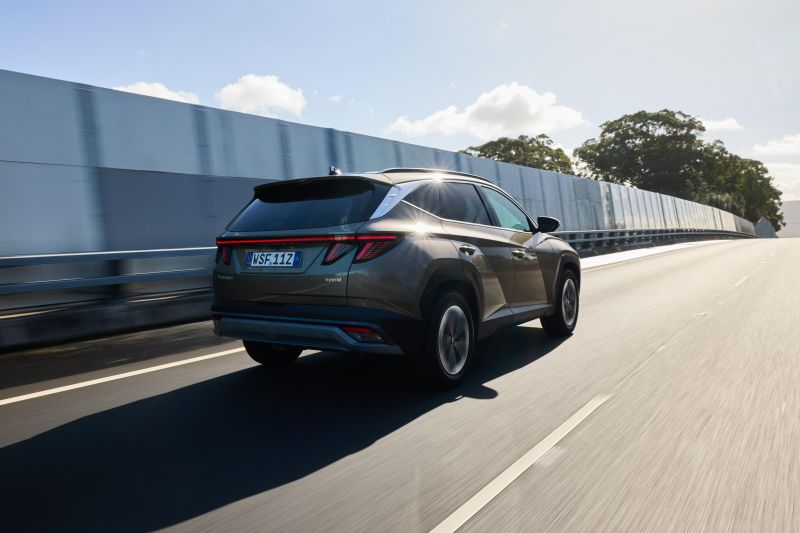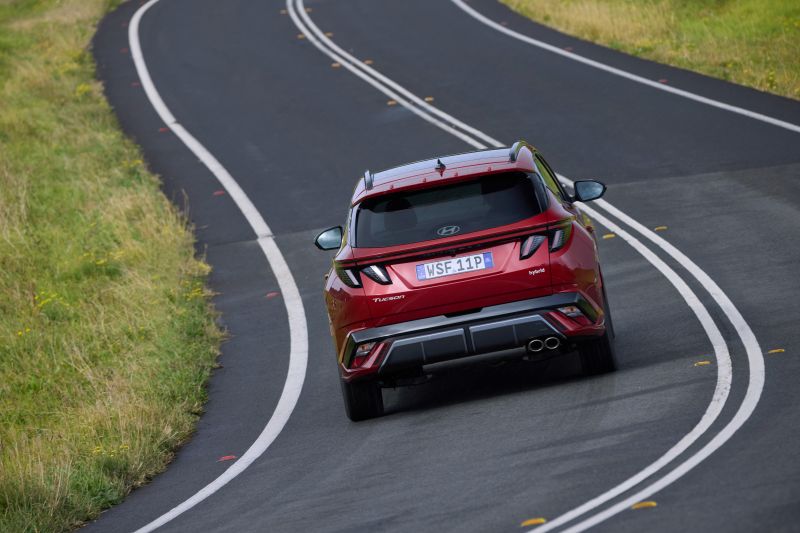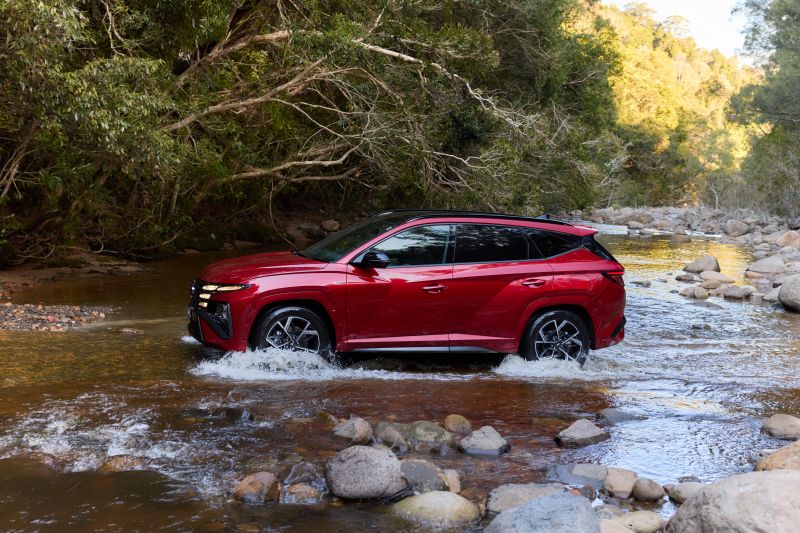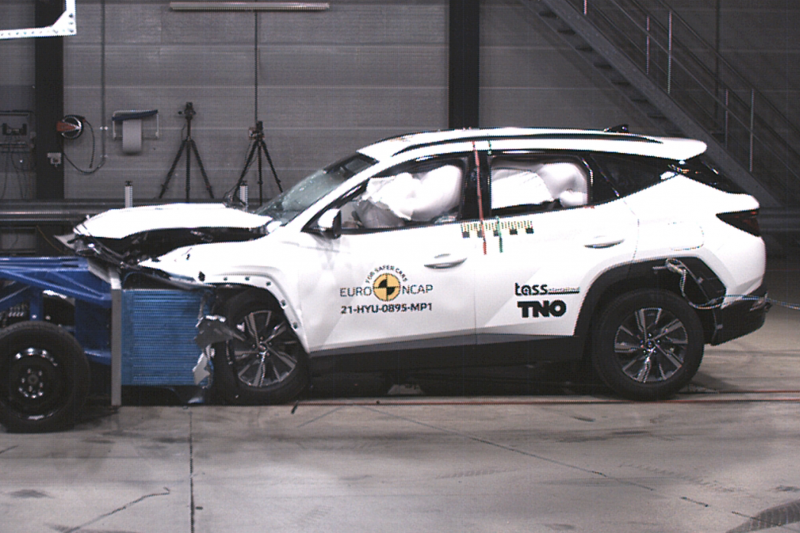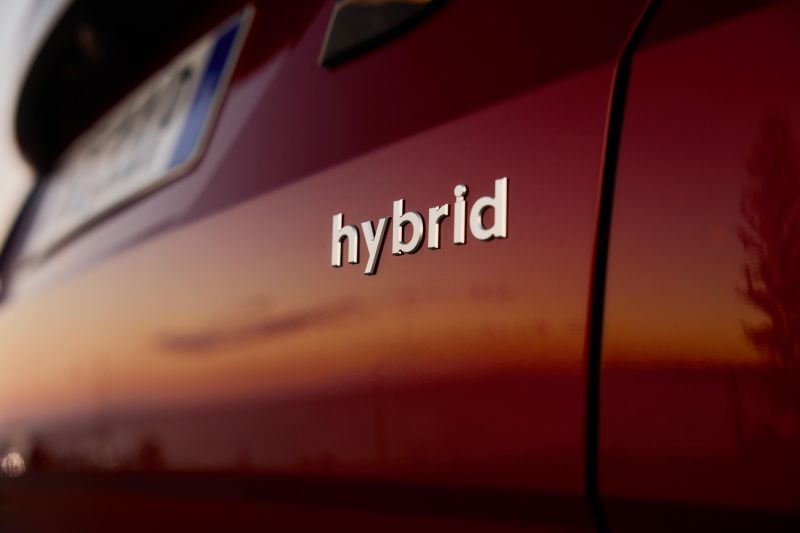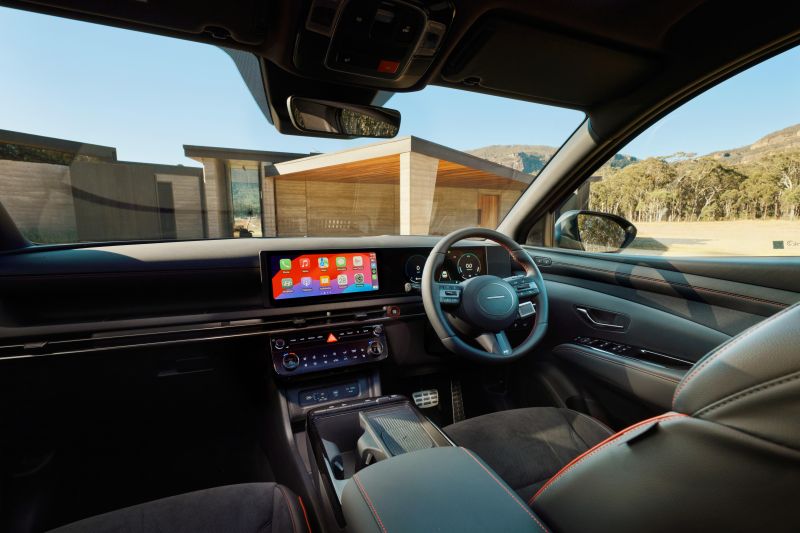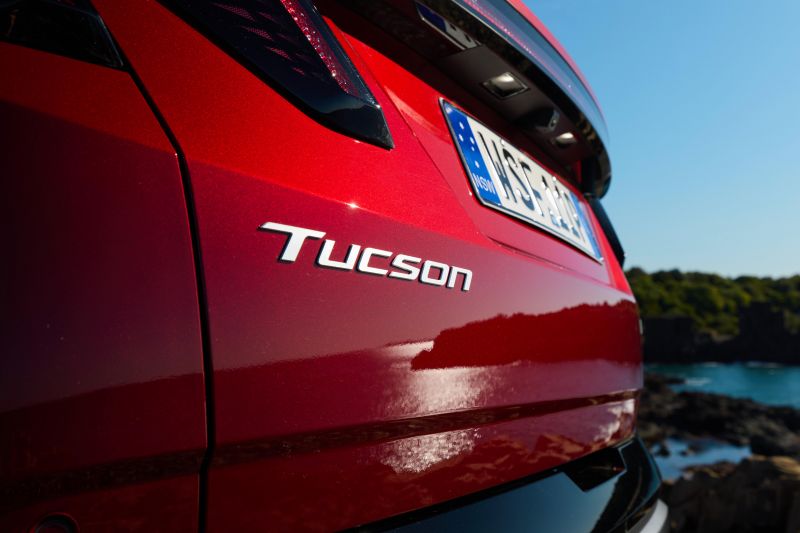Hyundai is finally taking the fight to Australia’s favourite SUV; the Toyota RAV4 Hybrid.
-
Elite
Although the Honda ZR-V and CR-V e:HEV, Kia Sportage Hybrid, and GWM Haval H6 HEV, offer some form of hybrid alternative to the RAV4, none has a full range to take on Toyota.
The 2025 Hyundai Tucson Hybrid is landing in Australia, and unlike Kia it’s offering an electrified powertrain across all trim levels. Within a sprawling range of 17 variants, there are no fewer than eight versions of Tucson Hybrid you can buy in Australia.
Prices start from $45,100 before on-road costs for the most basic petrol-electric Tucson, which is about $5500 more than the base petrol. That aligns the starting point of the Tucson Hybrid range with the mid-spec RAV4 GXL Hybrid.
The flagship Premium N Line AWD will set you back more than $60,000 on the road, which lines up pretty well with the most expensive RAV4 Edge AWD Hybrid. Quite a match up, then…
-
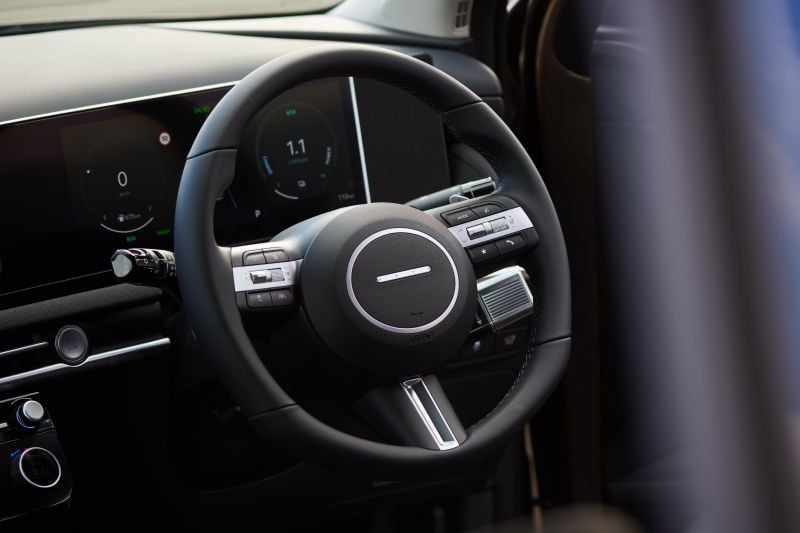
Elite
Regular petrol and turbo-petrol versions of the new Tucson are also coming, but only the hybrids were available during the Australian media drive. Hence, we’ll focus on just the electrified version today.
Has Korea finally come up with a proper contender for Japan’s top-seller?
How does the Hyundai Tucson compare?
View a detailed breakdown of the Hyundai Tucson against similarly sized vehicles.

Hyundai
Tucson
How much does the Hyundai Tucson cost?
The updated Tucson offers one of the most comprehensive ranges in segment – there are 17 models to choose from!
| Model | Price before on-road costs |
|---|---|
| 2025 Hyundai Tucson 2.0 FWD | $39,100 (+$3450) |
| 2025 Hyundai Tucson 1.6T HEV FWD | $45,100 (NEW) |
| 2025 Hyundai Tucson N Line 1.6T FWD | $45,100 (NEW) |
| 2025 Hyundai Tucson N Line 1.6T HEV FWD | $49,100 (NEW) |
| 2025 Hyundai Tucson Elite 2.0 FWD | $44,100 (+$3450) |
| 2025 Hyundai Tucson Elite 1.6T FWD | $46,100 (NEW) |
| 2025 Hyundai Tucson Elite 1.6T AWD | $48,600 (+$3950) |
| 2025 Hyundai Tucson Elite 1.6T HEV FWD | $50,100 (NEW) |
| 2025 Hyundai Tucson Elite 1.6T HEV AWD | $52,600 (NEW) |
| 2025 Hyundai Tucson Elite N Line 1.6T FWD | $48,600 (NEW) |
| 2025 Hyundai Tucson Elite N Line 1.6T AWD | $51,100 (+$3950) |
| 2025 Hyundai Tucson Elite N Line 1.6T HEV FWD | $52,600 (NEW) |
| 2025 Hyundai Tucson Elite N Line 1.6T HEV AWD | $55,100 (NEW) |
| 2025 Hyundai Tucson Premium 1.6T AWD | $55,600 (+$3950) |
| 2025 Hyundai Tucson Premium 1.6T HEV AWD | $59,600 (NEW) |
| 2025 Hyundai Tucson Premium N Line 1.6T AWD | $57,100 (+$3950) |
| 2025 Hyundai Tucson Premium N Line 1.6T HEV AWD | $61,100 (NEW) |
To see how the Tucson lines up with the competition, check out our comparison tool.
What is the Hyundai Tucson like on the inside?
While the exterior revisions may seem subtle, the interior has received a comprehensive update.
-
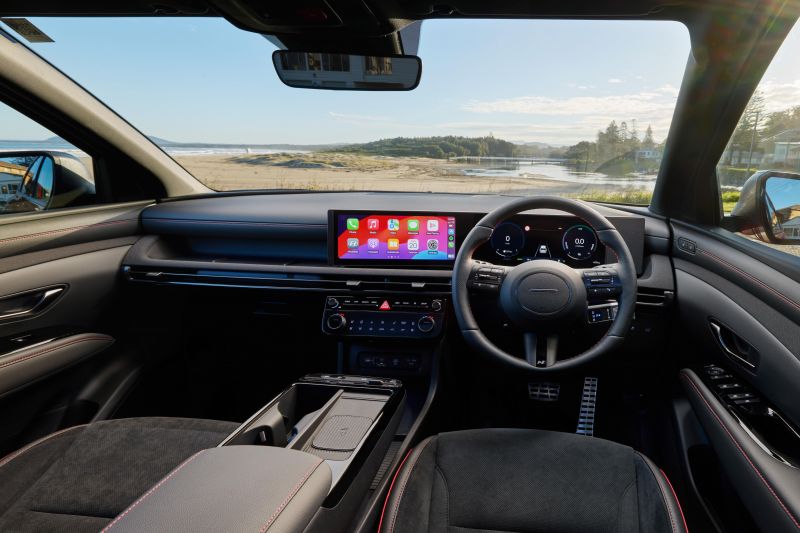
Premium N Line
Where facelifts tend to jazz up existing architecture or implement evolutionary changes rather than revolutionary ones, Hyundai has basically thrown out the Tucson’s old dash and made a whole new one.
Gone is the touch-capacitive waterfall and integrated displays, and in their place is a more modern and open plan design with the Hyundai-Kia dual 12.3-inch Connected Car Navigation Cockpit (ccNC) display layout.
Well, the base model doesn’t come as standard with the 12.3-inch digital instrument cluster unless you tick the N Line option box, but the ‘base’ cluster with 4.2-inch display is more convincing and appealing to look at than the Tucson’s previous analogue gauges, as well as the clock radio-style cluster on the Sportage.
The new screens are an improvement on the outgoing model’s 10.25-inch units, and the new interface is a big step forward on all fronts.
-
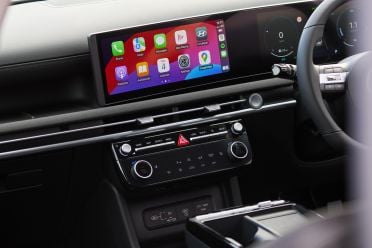
Elite -
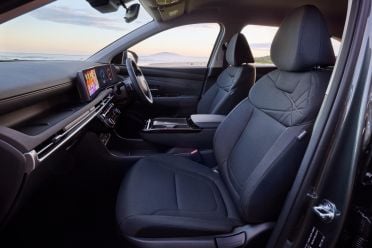
Tucson
You now get wireless Apple CarPlay and Android Auto standard across the range, as well as Bluelink connected services which includes app-based remote services, and safety features like automatic collision notification and SOS emergency call functions.
There’s connected navigation with live traffic updates and send-to-car address input via your smartphone – this is included from the mid-spec Elite, as is the 12.3-inch digital instrument cluster.
As we have found in other Hyundai and Kia models running this software, it’s easy to use and snappy in terms of response and animations. It feels very upmarket, and is fully featured to the point where it’s competitive with premium brands on paper.
Clarity of the displays is also a strong point, with crisp graphics and bright colours. These wouldn’t look out of place in a Genesis, though the cluster lacks the customisability of Volkswagen Group systems.
There’s a new touch-based climate control panel with rotary dials for temperature, and while we often lament capacitive controls they very much operate like physical buttons would. They do attract fingerprints, though.
Beneath the centre stack is a cubby deep enough for a handbag, and there are USB-C ports to charge your devices if you need. All models get a grippy wireless smartphone charger as standard, which is placed on the floating centre console next to the cupholders.
Ahead of the charger and cupholders there are extra physical buttons for the parking camera/sensors, and drive modes – at your fingertips, if you will.
More storage is available under the front-centre armrest cubby as well as in the door bins. Disappointingly, the door bins aren’t as deep or accommodating as those in a Volkswagen Tiguan.
-
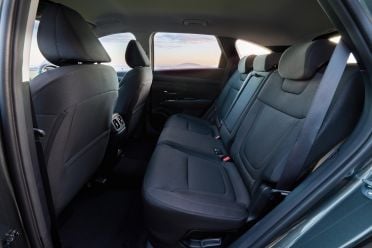
Tucson -

Premium N Line
Second-row accommodation remains a strength, thanks to its long wheelbase. Leg and knee room are up with the best in segment, while the relatively flat rear bench and minimal driveline hump in the floor mean you can carry three smaller people across on occasion if you need.
Even with the Premium’s panoramic sunroof there’s good headroom for taller people like myself. At 6’1 I had no issues sitting behind my preferred driving position, meaning if your little kids suddenly sprout into lanky teenagers the Tucson should be able to grow with them.
Two ISOFIX and three top-tether points feature, and there’s a fold-down centre armrest with cupholders. You also get rear air vents as standard but no separate climate controls on any Tucson variant.
The rear seats can be reclined fore and aft, and in the Premium the outboard ones are heated too. Rounding out the amenities are map pockets on the front seatbacks and USB-C charge ports behind the centre console and separate seat adjust controls on the inner edge of the front passenger seat for a chauffeur-style experience.
-
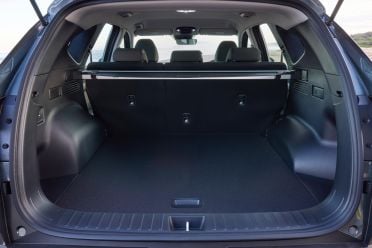
Tucson -
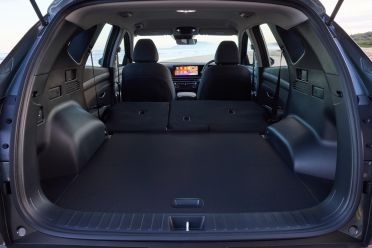
Boot space is actually better in the Tucson Hybrid than petrol models on paper, because the HEVs swap out the full-size spare wheel for a space saver.
Hybrid models have 582 litres with the rear seats up (VDA), expanding to a colossal 1903 litres with the back seats folded – and they almost fold completely flat. The petrols, meanwhile, have 539-1860 litres.
| Dimensions | Hyundai Tucson Hybrid |
|---|---|
| Length | 4640mm 4650mm (N Line) |
| Width | 1865mm |
| Height | 1665mm |
| Wheelbase | 2755mm |
| Cargo capacity (VDA) | 549-1860 litres (Petrol) 582-1903 litres (Hybrid) |
To see how the Tucson lines up with the competition, check out our comparison tool.
What’s under the bonnet?
The new Tucson is available with three different powertrains, two of which offer FWD and AWD options.
| Specifications | 2.0 MPi | 1.6 T-GDi | 1.6 T-GDi HEV |
|---|---|---|---|
| Engine | 2.0L 4cyl petrol | 1.6L 4cyl turbo-petrol | 1.6L 4cyl turbo petrol hybrid |
| Engine outputs | 115kW / 192Nm | 132kW / 265Nm | 132kW / 264Nm |
| Electric motor outputs | – | – | 37.4kW / 264Nm |
| System outputs | – | – | 172kW / 367Nm |
| Battery | – | – | 1.49kWh li-ion polymer |
| Transmission | 6-speed auto | 7-speed DCT | 6-speed auto |
| Driven wheels | FWD | FWD or AWD | FWD or AWD |
| Weight (kerb) | 1495-1616kg | 1526-1649kg (FWD) 1591-1714kg (AWD) |
1626-1745kg (FWD) 1686-1806kg (AWD) |
| Fuel economy (claimed) | 8.1L/100km | 6.7L/100km (FWD) 7.2L/100km (AWD) |
5.3L/100km (FWD, AWD) |
| Fuel tank capacity | 54 litres | 54 litres | 52 litres |
| Fuel requirement | 91 RON | 91 RON | 91 RON |
| CO2 emissions | 184g/km | 151g/km (FWD) 164g/km (AWD) |
121g/km (FWD, AWD) |
| Emissions standard | Euro 5 | Euro 5 | Euro 5 |
| Braked towing capacity | 1650kg | 1650kg | 1900kg |
| Towball download | 100kg | 100kg | 100kg |
To see how the Tucson lines up with the competition, check out our comparison tool.
How does the Hyundai Tucson drive?
Having spent plenty of time in hybrid versions of the Kia Sportage and larger Hyundai Santa Fe, the Tucson Hybrid offers few surprises and also makes a solid case for itself against rivals like the RAV4 Hybrid and H6 HEV.
-
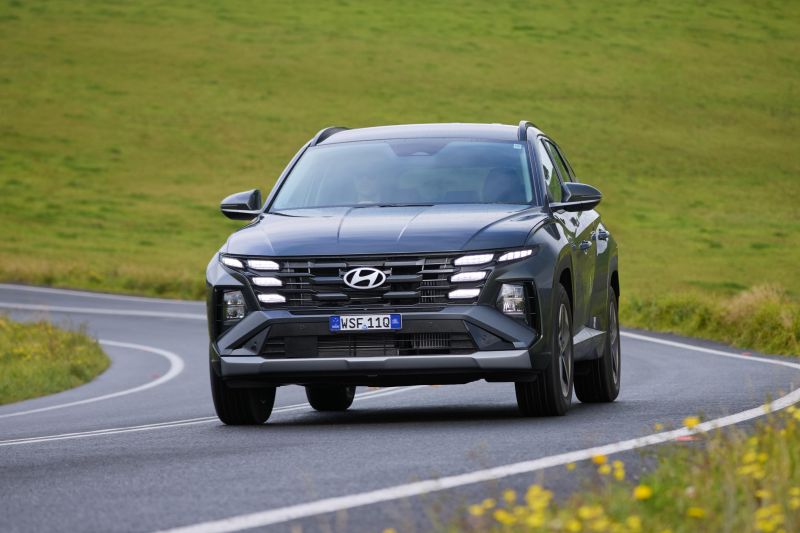
Tucson
Hyundai and Kia’s approach to hybridisation is a little different to Toyota’s, aiming to balance efficiency with performance rather than outright saving absolutely every drop of fuel. It’s also more conventional to drive.
Like most full hybrids the Tucson HEV starts in silence save for a few bongs as part of the startup chime, and if you sit around for long enough the turbo petrol engine might fire up to warm up on a cold start.
You will roll off in EV mode at carpark speeds or when you engage Reverse, and from there the Tucson’s electrified underpinnings do the hard work for you in selecting when and where to employ electric power, combustion power, or both.
I have praised the likes of the Kia Niro HEV for leaning on battery power more than a Toyota hybrid with nickel-metal hydride batteries, but the Tucson (and Santa Fe) can be a little inconsistent with how much it wants to lean on e-power.
Sometimes you’ll accelerate to 40km/h in EV mode, other times the petrol engine will fire up and assist almost immediately after you set off. There’s also no way to lock it into EV mode like you are afforded in Toyotas.
But, there are benefits to be enjoyed here. With the electric motor mounted to the six-speed automatic transmission, as opposed to driving through an e-CVT like you might find in key rivals, the Tucson Hybrid will shuffle through gears like a normal ICE car regardless of whether it’s in EV mode or not.
It’ll also just pop into EV mode at various speeds. We saw it switch off the engine and hold 100-110km/h in EV mode multiple times driving on Sydney’s Pacific Highway and other major highways.
My view is the hybrid needs an extra gear or two, however. At 100km/h the engine is spinning at around 2000rpm and the instant fuel consumption readout is reading around 7.0L/100km mark. It could be better with a longer final ratio to be more efficient on the highway.
-
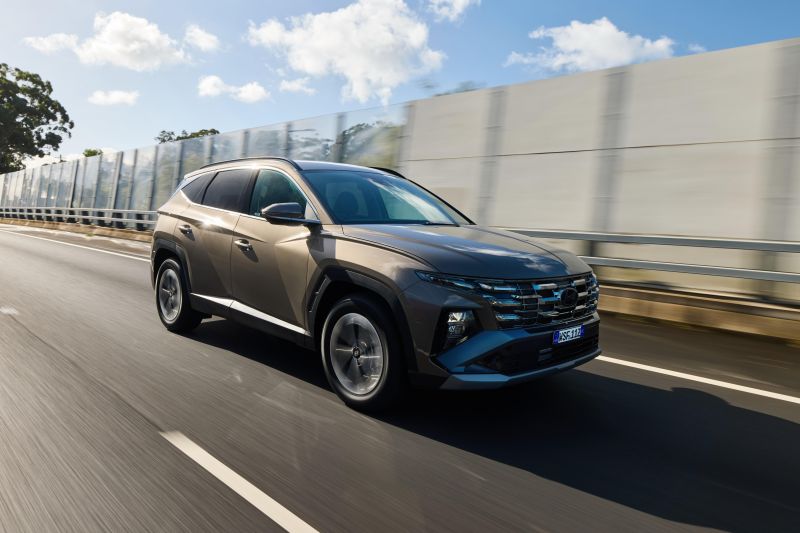
Elite
With 172kW and 367Nm under foot – the latter available from 1000-4100rpm – the Tucson Hybrid hardly feels like a Prius when you hammer it. If anything it’s pretty peppy and doesn’t have the CVT whine you get from a RAV4 Hybrid under load.
The engine is pretty refined for the most part and barely heard under acceleration unless you absolutely mash it, which makes progress feel quick if you need to make a dash for it. Hyundai Australia doesn’t quote a 0-100km/h time, but the less powerful short-wheelbase model in the UK quotes 8.2 seconds for the 2WD.
Road and wind noise were also reasonably well suppressed without being luxury car quiet. We tested both the base model on 18s and the N Line with 19s, and both wheel and tyre packages proved to be comfortable and refined.
I did notice in Sydney’s very long WestConnex tunnel though that noise from trucks through the side windows was a bit louder than I’d like. While the windscreen gets acoustic laminated glass across the range, the side ones do not.
We also drove the Tucson Hybrid in town and up some twisties heading into Laguna north of Sydney, and again the it proved surprisingly fun to drive particularly in N Line AWD guise.
It’s not overtly sporty, but it offers nicely balanced and controlled dynamics with a slight lean to the more engaging side of things. The Tucson doesn’t get a bespoke Australian ride and handling tune like the Sportage, though the steering has been locally developed as has the E-Motion Drive technology.
What is E-Motion Drive? It’s Hyundai-speak for a torque vectoring system that’s exclusive to the hybrid. Basically, the electric motor has been calibrated to minimise pitching over speed humps and smoothen out acceleration in normal driving, while also optimising traction in corners.
I’m not going to tell you I felt a dramatic difference during our testing, but I can attest to the Tucson’s controlled and refined nature across the board – perhaps the seamless feel is what Hyundai is aiming for…
-
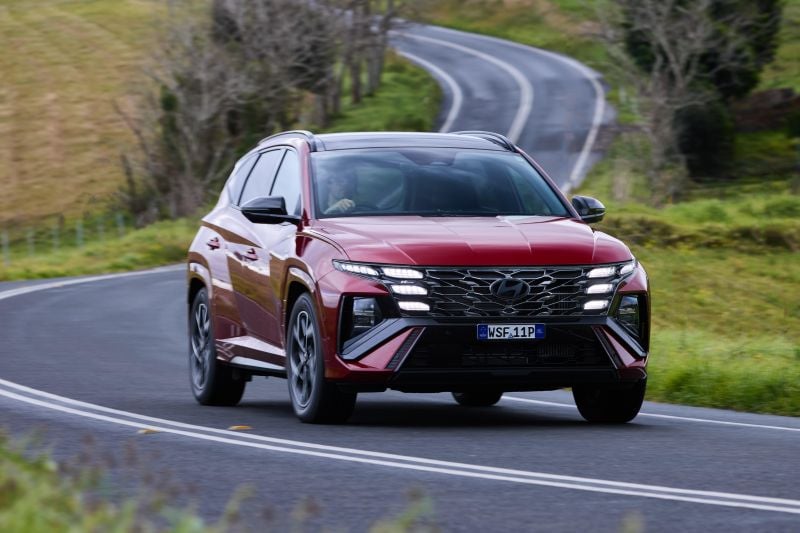
Premium N Line
Fuel consumption is an important consideration for a hybrid vehicle, and while our extended launch drive with plenty of highway touring and high-speed B-roads isn’t indicative of the target market’s typical commute, the Tucson Hybrid is more efficient than its ICE siblings… but isn’t quite as thrifty as a RAV4 Hybrid.
The AWD was showing low 6.0L/100km after the higher speed and dynamic sections, while the FWD ended on high 5.0s after more urban and city driving.
Both figures aren’t quite as good as what Hyundai claims, and a RAV4 will do high 4.0s into mid 5.0s without really trying. You can offset that with the Tucson’s superior driving performance and dynamics, I guess.
The Tucson Hybrid is notably more efficient than the tired base 2.0 MPi atmo petrol engine and the 1.6 T-GDi turbo-petrol which is known for its awkward transmission. The diesel will be missed if you’re likely to spend a higher ratio of your time on the open road, but the hybrid is otherwise better in most respects.
You can also use the paddle shifters to adjust regen in Eco mode or shift ratios in Sport. The regen is fairly mild in its standard Auto setting but there are four stages that can be toggled via the shifters.
Other developments include Baby Mode, which like E-Motion Drive smooths out acceleration and braking inputs using the electric motor to offer a less nausea-inducing experience for bubs. We didn’t use it, but it’s toggled using the My Mode profile in the drive mode selector.
In terms of driver assistance, Hyundai has developed a solution for the infuriating Speed Limit Assist chimes that beep at you when you enter a new speed zone, when you travel more than 2-3km/h (indicated) over the detected limit – even if it has detected wrong.
Long press the mute button on the steering wheel and the Tucson will automatically disable the audible chime, though you’ll have to do this each time you start the car. Hyundai says this is a global solution, though it’s worth noting audible speed sign notifications are not required by law in Australia unlike Europe.
Otherwise the 2025 Tucson introduces Highway Driving Assist (HDA) for the nameplate in Australia, which activates the adaptive cruise and lane centring functions and uses navigation data for semi-autonomous highway driving capability.
HDA is standard from Elite models and up; adaptive cruise control with stop/go is standard across the range as is separate Lane Following Assist (centring), as well as various aids like blind-spot and rear cross-traffic assists, safe exit warning and tyre pressure monitoring – the camera-based Blind Spot View Monitor is reserved for the Premium.
The available surround camera system with 3D view on the Premium is worth noting. It offers good clarity, while the three-dimensional projection of the vehicle into the surroundings is up there with premium makes. No excuse for scraped wheels or dinged bumpers, then.
We also briefly took the Tucson on dirt, navigating some light gravel trails near Laguna on our way to the lunch stop. Behind the wheel of the Elite N Line AWD, I felt the Tucson handled itself pretty well.
Despite plenty of puddles, potholes, and muddier bits after days of rain, the Tucson never felt like it lacked traction regardless of the terrain. Is it an off-roader? No, but it can leave the blacktop for light-duty stuff with confidence. The FWD ones made it through just fine as well.
If you opt for the AWD you get additional terrain modes accessed via the drive mode selector. There are snow and mud modes which tailor the drivetrain and traction control to optimise grip and drivability on loose surfaces.
These didn’t really come into play on the gravel streets we drove on, but at least they’re there should you head to alpine regions on occasion, for example.
What do you get?
The Tucson is available in three distinct trim levels in Australia.
Tucson standard equipment:
- 18-inch alloy wheels
- Full-size spare wheel (2.0 MPi)
- Space saver spare (Hybrid)
- Dark chrome front grille
- Roof rails
- LED headlights (NEW)
- LED daytime running lights
- LED side indicators
- LED tail lights
- Heated and auto-folding side mirrors
- Cloth interior upholstery
- 4.0-inch instrument cluster display
- 12.3-inch touchscreen infotainment system with OTA updates (NEW)
- 6.6-inch climate control panel (NEW)
- Wireless Apple CarPlay, Android Auto
- Digital radio
- 4 x USB-C outlets
- 6-speaker sound system
- Wireless phone charger
- Electronic parking brake
- Leather-wrapped steering wheel
- Leather-wrapped shifter
- Premium cloth dashboard and door centre trim
- Black cloth upholstery
- Power driver’s seat lumbar
- Bluelink connected services
- Remote control of climate and vehicle functions
- Vehicle settings management
Tucson Hybrid adds:
- E-Motion Drive
- Smart regeneration braking
- Paddle shifters
- After-blow system
Tucson Elite adds:
- 18-inch alloy wheels
- Dark chrome grille
- Front parking sensors
- Rear privacy glass
- Rain-sensing wipers
- Solar control windshield glass
- Black leather-appointed seats
- Heated front seats
- 10-way power driver’s seat
- 12.3-inch digital instrument cluster
- Satellite navigation
- Additional Bluelink functionality
- Live traffic updates
- Navigation send to car
- Voice recognition for POI lookup, vehicle controls
- Dual-zone climate control
- Keyless entry with push-button start
- Remote start
- Shift-by-wire gear selector and paddle shifters (1.6 T-GDi)
- Luggage net
Tucson Premium adds:
- 19-inch alloy wheels
- Glossy dark chrome front grille
- Silver skid plate
- Panoramic glass sunroof
- Power tailgate
- Head-up display
- Bose premium sound system
- LED interior ambient lighting
- Heated steering wheel
- Black, brown, or grey leather upholstery
- Ventilated front seats
- Heated rear outboard seats
Options
All Tucson grades offer the N Line Package, which varies in price depending on model.
N Line adds:
- 19-inch N Line alloy wheels
- Suede and leather interior interior
- 12.3-inch digital instrument cluster (Tucson)
- N Line dark silver grille
- N Line front, rear bumpers
- Full LED rear lighting (Tucson)
- Hidden DRLs
- Rear spoiler
- Twin-tip exhaust
- Projector-type LED headlights
- Intelligent Front Lighting System
- Gloss black exterior accents
- Body coloured cladding
- Shift-by-wire (2.0 MPi)
- Alloy pedals
- Black paddle shifters
Colours
The 2025 Hyundai Tucson is available in a range of exterior paint colours, depending on variant.
Tucson colours:
- White Cream
- Shimmering Silver
- Titan Gray
- Cashmere Bronze
- Amazon Grey
- Phantom Black
- Deep Sea
- Pine Green
Tucson N Line colours:
- White Cream
- Titan Gray
- Phantom Black
- Ultimate Red
All colours except White Cream cost an additional $595, while Pine Green Matte is available for $1000.
The Tucson Premium can also be ordered with a two-tone interior for $295, though this isn’t available on the N Line.
Is the Hyundai Tucson safe?
The updated Tucson will carryover the pre-facelift model’s five-star ANCAP safety rating, which will be updated to include Australian-market hybrid models.
Based on tests of the Euro NCAP tests of the SWB Tucson, the Hyundai scored 86 per cent for adult occupant protection, 87 per cent for child occupants, 66 per cent for vulnerable road users and 70 per cent for safety assist.
Standard safety features include:
- 7 airbags incl. front-centre inflators
- Autonomous emergency braking (AEB)
- Pedestrian detection
- Cyclist detection
- Junction assist
- Adaptive cruise control with stop/go
- Blind-spot assist
- Rear cross-traffic assist
- Intelligent speed limit assist
- Lane Following Assist (centring)
- Lane keep assist
- Reversing camera
- Rear parking sensors
- Leading vehicle departure alert
- Second-row pretensioner seatbelts (NEW)
- Safe exit warning
- Rear occupant alert
- Tyre pressure monitoring
- Hyundai Bluelink services
- Automatic collision notification
- Emergency call (SOS) function
- Alert services including geo-fencing, valet, speed and time alerts
The mid-range Elite and Premium variants gain advanced rear occupant alert, navigation-based Smart Cruise Control and Highway Driving Assist, the latter of which combines the adaptive cruise control and lane centring systems.
Premium grades also get a blind-spot view monitor, reversing AEB and a surround-view camera with 3D view.
How much does the Hyundai Tucson cost to run?
The Tucson is covered by Hyundai’s five-year, unlimited-kilometre warranty.
| Running costs | Hyundai Tucson Hybrid |
|---|---|
| Warranty | 5 years, unlimited kilometres (vehicle) 8 years or 160,000km (HV battery) |
| Roadside assistance | Lifetime (service activated) |
| Service intervals | 12 months or 10,000 kilometres |
| Capped price servicing | 5 years |
| Total capped price service cost | $2040 |
CarExpert’s Take on the Hyundai Tucson
This is a car that can really give Hyundai Australia a shot in the arm.
After slowly losing volume and share to other brands, including Kia, the fact the Korean giant is really pumping out electrified products is a promising sign for consumers wanting more choice in key family segments.
While the hybrid-only Santa Fe has polarising looks, the mid-sized Tucson is an already popular option in Australia’s hottest new vehicle segment, and the hybrid should only build on that.
Some 5000 units are already here, on the water, or waiting to be shipped to Australia. If you get in early, you could have one in your driveway within three months – unheard of these days.
Hyundai has noted there will be supply limitations after the launch, but compared to the Kia Sportage Hybrid which is capped around 300 vehicles per month, the Tucson is more readily available and offers a wider spread of variants and options to help customers find the car that’s right for them.
And if hybrid doesn’t sell it, the punchy performance, good efficiency and refined on-road manners make this a compelling package from behind the wheel, while the solid level of inclusions across the board enhance the value equation.
While a RAV4 Hybrid may be more efficient, the Tucson is better to drive, nicer to look at and sit in, and also offers superior technology that rivals premium marques for integration and cohesion… mostly.
Areas for improvement? A taller final ratio for highway driving would make it more efficient, the annoying speed limit assistant would be better turned off entirely, and some features being reserved for the N Line or Premium herds you in a particular direction if you have some non-negotiables.
If you’re in the market for a mid-sized SUV though, I’d strongly suggest adding this to your shortlist.
Click the images for the full gallery
MORE: Buy a Hyundai Tucson
MORE: Everything Hyundai Tucson

